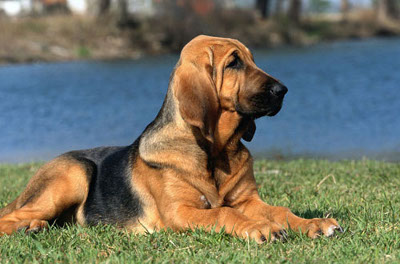Bloodhound
Category: Hound Dogs

Facts about Bloodhound Dog, "Scientific name for Bloodhound Dog, or domestic canine, is Canis lupus familiaris". The Bloodhound Dog is among the oldest affectionate breeds of dogs uses scent while hunting. The Bloodhound Dogs are built for endurance rather than speed and they are featured by thin and loose coat with wrinkles in its head and throat. The Bloodhound Dogs are a little bit shy, though, they are masters of correction. The Bloodhound Dogs are frequently used as trail dogs because of their friendly and kind nature. The Bloodhound Dog can either have liver and tan, red or black and tan colors that are sometimes flecked with white.
Bloodhound Dogs have two times the amount of ear muscles than people. A Bloodhound Dogs can hear a sound at four times the distance of a human. Sound frequency is measured in Hertz (Hz) Def-Hertz is the measurement of frequency, explicitly it's one cycle per second. The higher the Hertz are, the higher the pitched the sound is. Bloodhound Dogs hear best at 45,000 Hz to 65,000 Hz, while humans hear best at around 20 Hz to 20,000 Hz.
Temperament
The Bloodhound Dog is a tireless trailer. Although he is obstinate and often independent, he is loyal, placid and even gentle and he can be trusted around children. He isn’t such an easy dog to train obedience, but training Bloodhound Dogs to trail is the easiest thing you can do with this dog. The Bloodhound Dog are often used by police and other people to track thieves or even prisoners who have escaped.
Body, Weight And Color
The average height of the Bloodhound Dog is 23 to 27 inches (58.4 to 68.5 cm) tall at the shoulders. The average weight is 80 to 110 pounds (36.3 to 49.9 kg). The Bloodhound Dog generally feature a skeletal structure with most weight concentrated in the bones. Its saddle-marked coat is tough and covered with fur without any hair. Bloodhound Dogs are marked by either black, liver, tan or red colors
Health
The number one heath problems amongst Bloodhound Dogs is obesity, so always make sure your Bloodhound Dog doesn't get to fat. Many foot problems that Bloodhound Dogs have are just an issue of long toenails. They normally suffer gastrointestinal related ailments such as bloat alongside other ailments such as skin, ear and skin complications. The major concerns relating this dog include Epilepsy, Fold Dermatitis, entropion, ectropion and elbow dysplasia.
Bloodhound Dogs sweat glands are between their paw pads.
A Bloodhound Dog sees in color and have better low light vision. Bloodhound Dogs have three eyelids, a lower lid, an upper eyelid lid and a third lid, that is called a haw or nictitating membrane, this keeps the dogs eye protected and moist. Bloodhound Dogs eyes have a special membrane for seeing better at night, called a tapetum lucidum - a dogs reflective layer in the choroid chiefly of nocturnal, causing the eyes to glow when light at night hits the eyes and they consist of some layers of smooth flat cells covered by a section of double deformed crystals
Bloodhounds need some exercises because their bodies were made to go through any kind of hardship. One thing you should note about the Bloodhound is that, once he is on the trail, he can’t be called off. That is why; he must be exercised in a safe area.
All dogs are identical in makeup big or small– 42 permanent teeth and 321 bones. Bloodhound Puppies have 28 teeth and when they become adult Bloodhound Dogs they have 42 teeth.
Female Bloodhound Dogs are in heat for matting for about 20 days twice a year. Bloodhound Puppies for their first few weeks will sleep ninety percent of the day and their vision is not fully developed until after the first month. Female Bloodhound Dogs are pregnant for 60 days before they’re puppies are born
Care
Bloodhound Dogs wrinkles require daily cleaning because he drools a lot and his ear tips always drag in food. The ear canals need regular cleaning but for the coat, its cleaning isn’t a must. The Bloodhound Dog are both indoor and outdoor dogs. The Bloodhound Dog aren’t such tidy dogs, for those people obsessed with cleanliness; this trailing expert may not be your pet.
When purchasing a Bloodhound Dog from a breeder, make sure to find a good breeder with references, check at least two to three of the puppies that were purchased from this breeder.
The average life span for the Bloodhound Dog is 12 to 15 years. In 1885 the Bloodhound Dog was recognized (AKC) American Kennel Club.
A Bloodhound Dog’s mouth can apply approximately 150 to 200 pounds of pressure per square inch and an American Pit Bull Terrier, German Shepherd Dog and a rottweiler can have 320 LBS of pressure on avg.
Bloodhound Dog’s nose prints can be used to identify them, their nose prints are like a humans finger print. A Bloodhound Dog smells more than 1,000 times stronger than that of a human. A dog’s nose, secretes a thin layer of mucous that helps it absorb scent, after that they lick their noses and sample the scent through their mouth.
Average body temperature for a Bloodhound Dog is between 101 to 102.5 degrees
A Bloodhound Dog is an omnivore, (definition-they eat both other animals and plants). All Dogs are direct descendants of wolves.
Only humans and dogs have prostates and a dog doesn't have an appendix.
Bloodhound Dogs pant to keep cool with 10 to 35 breaths per minute with an average of 24 breaths per minute. A large dog breed resting heart beats between 60 to 100 times per minute, and a small dog breed’s heart beats on average between 100 to 140 pant a lot.

 Back To Category Hound Dogs
Back To Category Hound Dogs